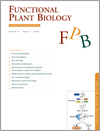
Functional Plant Biology
Volume 47 Number 7 2020
FP19159The function of KptA/Tpt1 gene – a minor review

Phosphotransferase KptA/Tpt1 plays an essential role in tRNA splicing and ADP-ribosylation of organisms, which mainly transfers the 2'-PO4 group of tRNA to NAD+ for ADP ribosylation. However, the KptA/Tpt1 gene has a variety of biological functions in different organisms. Here, we summarise and analyse the structure, evolution and function of KptA/Tpt1 from prokaryotes to eukaryotes and put forward some suggestions for existing problems and future research.
FP19161Acclimation strategy and plasticity of different soybean genotypes in intercropping
 , Ting Pang
, Ting Pang  , Nasir Iqbal
, Nasir Iqbal  , Iram Shafiq
, Iram Shafiq  , Milan Skalicky
, Milan Skalicky  , Marian Brestic
, Marian Brestic  , Muhammad E. Safdar
, Muhammad E. Safdar  , Maryam Mumtaz
, Maryam Mumtaz  , Aftab Ahmad, Muhammad A. Asghar, Ali Raza, Suleyman I. Allakhverdiev
, Aftab Ahmad, Muhammad A. Asghar, Ali Raza, Suleyman I. Allakhverdiev  , Yi Wang, Xiao C. Wang, Feng Yang, Taiwen Yong
, Yi Wang, Xiao C. Wang, Feng Yang, Taiwen Yong  , Weiguo Liu
, Weiguo Liu  and Wenyu Yang
and Wenyu Yang
Shading significantly reduces the yield and quality of soybeans. By testing different soybean genotypes at various growth stages, we demonstrated that the plasticity exhibited by the plants allowed them to adjust to different degrees of shade. Early stage shading resulted in significant morphological changes compared with later shading. The leaf anatomy was markedly affected with late-stage shading. Shading at vegetative stages significantly altered the light saturation point, and early shading increased the activities of antioxidant enzymes. Our results highlight the effects of shading stress on the relationship between physiological and biochemical changes in growth, development, and plasticity of different soybean genotypes.
This study presents the dynamic responses of photosynthetic and photochemical traits, which directly reflect plant growth and health in response to heat interference during drought in wheat and sorghum. We found that both species opened stomata slightly more under heat interference during drought and did not further reduce carbon assimilation rate, suggesting the importance of transpirational cooling rather than water conservation under this cross-stress condition.
Understanding physiological responses of plants to shrub encroachment is essential for explaining shrub encroachment. We measured physiological parameters of species and soil water content and results showed that plants enhanced drought resistance abilities by regulating antioxidant systems and osmotic adjustment compounds. We recommend increasing surface clay content to increase water holding capacity to restore the zonal vegetation of Stipa bungeana.
Most plant species with upright growth receive light for photosynthesis on the upper side of their leaves and are better lit at the top of the canopy. Modern artificial lighting systems in horticultural greenhouses are placed between the plant rows and irradiate the lower leaf side and the bottom part of plant. Understanding the plant response to the light direction is fundamental in designing successful strategies of lighting in greenhouses, particularly in the northern hemisphere.
FP19350Antisense-mediated S-adenosyl-L-methionine decarboxylase silencing affects heat stress responses of tobacco plants
 , Katerina Karamanoli, Helen-Isis A. Constantinidou and Kalliopi A. Roubelakis-Angelakis
, Katerina Karamanoli, Helen-Isis A. Constantinidou and Kalliopi A. Roubelakis-Angelakis
Polyamines seem to exert multifaceted effects in plant stress responses, and in particular in heat stress, which is a potential threat to global crop production. In this respect, silencing the S-ADENOSYL-L-METHIONINE DECARBOXYLASE gene, a key gene from the polyamine biosynthetic pathway, resulted to enhanced sensitivity to heat stress and an irreversible injury upon return to normal conditions. These data reinforce the contribution of increased polyamine homeostasis to heat tolerance that might be targeted via traditional or biotechnological breeding for developing heat-tolerant plants.
FP19274Variations in drought tolerance components and their association with yield components in finger millet (Eleusine coracana)
 , Shiwesh Kumar, Ragimasalawada Madhusudhana, Ganapathy K. Nanaiah, Swarna Ronanki and Vilas A. Tonapi
, Shiwesh Kumar, Ragimasalawada Madhusudhana, Ganapathy K. Nanaiah, Swarna Ronanki and Vilas A. Tonapi
Finger millet has gained considerable attention worldwide due to its nutritional and health benefits. Drought is the major abiotic stress which destabilise the productivity of this crop. This study examines the role and variability of key drought adaptive traits for yield stabilisation. The findings of this study will give insights on the contribution of drought tolerance components and breeding strategies for their exploitation for improving the yield under drought.



